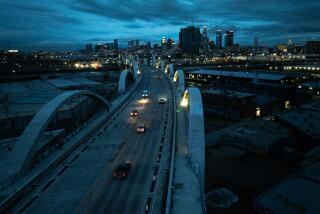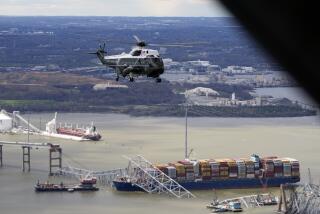Iraqis mourn broken link to the past
- Share via
BAGHDAD — An elderly man sat on a chair in front of his house, lamenting the loss of yet another piece of his past. A short distance away, the skeletal remains of the Sarafiya Bridge dangled over the Tigris River.
Focus on the steel-frame bridge, where a truck bomber killed at least 10 people early Thursday, was quickly diverted by the lunch-time attack at the heavily guarded parliament building. That’s not unusual in Iraq, where brutal mornings often give way to uglier afternoons.
But to those who lived near the fallen bridge, the loss was as heartbreaking as a death in the family. Not only did the structure serve as a symbol of better times, when children frolicked in the water below and trains chugged along its railway tracks.
It was an icon that had endured in a place where many have perished.
Since the U.S.-led invasion in March 2003, Iraqis have watched their historical treasures fall to the ensuing chaos. The capital’s National Museum was beset by looters as Saddam Hussein fled, and ancient treasures were lost. Archeological sites have been picked over by robbers looking to profit from sales of antiquities. Mosques have been bombed. The storied Mutanabi Street book market in Baghdad was ripped apart by a bomb last month, one of several famous bazaars that have been targeted.
The Sarafiya Bridge fell into the Tigris River shortly after 7 a.m. Thursday when a truck loaded with explosives blew up. The frame cracked, and huge chunks fell away. Vehicles tumbled 30 feet into the water below. Some people swam to safety, but at least 10 died. The bridge was left a mangled wreck.
“Last year I lost my elder brother,” said the man sitting in front of his house, Sahib Abdul-Razzaq, 67. “Believe me, I feel today as if my other elder brother has died.”
Asad Ibrahim, 41, grew up near the bridge and remembered when people in fancy clothes used to stay out until dawn in the casinos and restaurants lining both sides of the river.
“How many times we swam under this bridge since our childhood!” Ibrahim, an engineer, said. “When we were kids, we would watch the train passing over it. It is a heritage site.”
At a mini-market on a street that served as an approach, Maytham Hameed, 31, said his family’s house would rattle and shake each time a train crossed. “We all have many memories related to the Sarafiya Bridge,” he said.
British forces commissioned the crossing in the late 1940s and their use of concrete and steel was a first for the city. At a time when other bridges in Baghdad were little more than floats, residents saw the Sarafiya Bridge as a marvel of modern design. Its seven sections spanned 1,485 feet across the water and linked the train station in eastern Baghdad to the one on the western side of the city.
Designed for the railroad, it was converted for vehicular and pedestrian use in 1989. It has been known variously as the Sarafiya Bridge, the Steel Bridge, the Train Bridge, and the New Bridge and was one of the 10 connecting east and west Baghdad. Now, there are nine.
On Friday, Iraqi families, women in black abayas, and young men came to take a closer look at the ruins. Blood stains were visible on the gnarled steel. Boys waded in the water, amid the wreckage, looking for souvenirs.
Some worried about the practical implications of the bridge’s loss. They said traffic, already dreadful because of military checkpoints, would become far worse.
Many cited the bombing as the latest example of the failure of U.S. and Iraqi security forces to control insurgents.
Saleem Jaboori said the attack on the bridge, which linked the Shiite-dominated neighborhood of Atifiya to Sunni-majority Waziriya, was symptomatic of Iraq’s ills.
Most, though, just mourned the loss of simple pleasures the bridge had offered.
“Women here cried bitterly when they saw it in this condition,” said Mustafa Hazim, 22, who sat alone, smoking a cigarette and listening to music through an earphone.
Hazim, who lives a few hundred feet up the river in Atifiya, was awakened by the blast and ran toward the smoke. When he saw what had happened, he raced back to his neighborhood to break the news to others.
Many of the women wept, he said. Amina Hameed Salman, 37, was one of them. She and her brother, Alaa, reminisced about the bridge as they stood at the gate of their house on the main road leading to the crumbled remains.
“We were raised with it,” said Alaa, who raced to the scene after hearing the blast. “I was stunned, and I kept saying ‘Why?’ ”
“I cried bitterly when I saw the bridge,” Amina said. “It’s as if an elderly relative has died.”
Times staff writers Said Rifai and Saad Khalaf contributed to this report.
More to Read
Sign up for Essential California
The most important California stories and recommendations in your inbox every morning.
You may occasionally receive promotional content from the Los Angeles Times.














